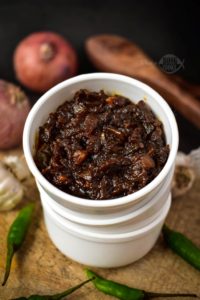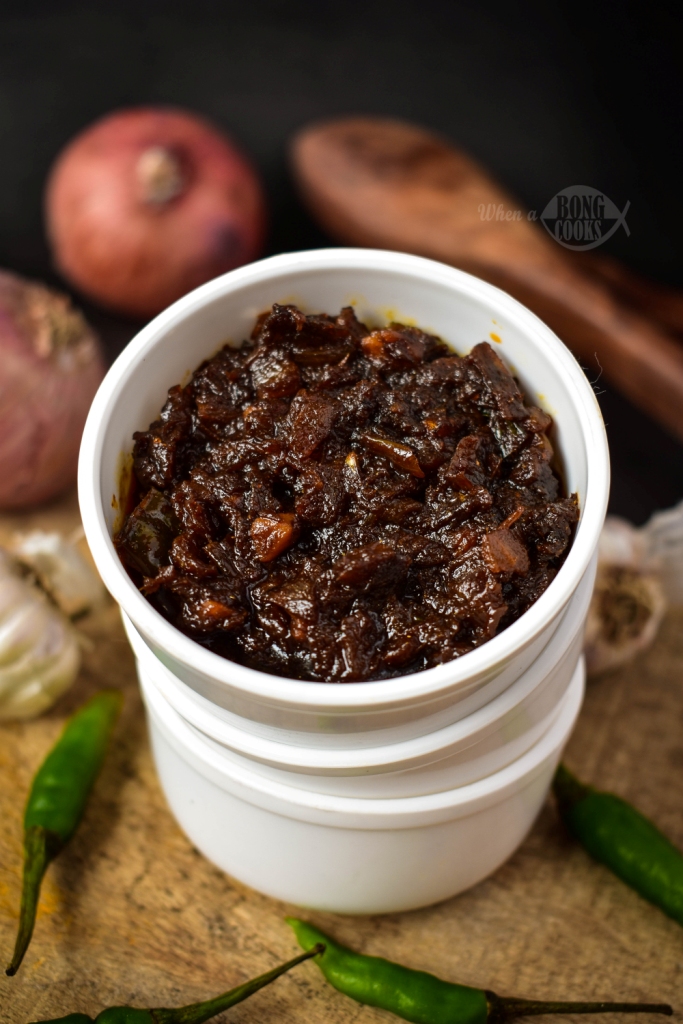
Image source: When a Bong Cooks (https://whenabongcooks.com)
Food is central to our social identities and forms an indispensable part of our community building. There are always specific recipes that are almost synonymous with our identity and constitute the collective food palette when we talk about the identity of any community. Shedol shutki is one such that is almost synonymous with the Sylheti community of Assam. Shutki is the generic term for dried fish. Shedol refers to a particular kind of shutki. They are ‘marker” foods for the Sylheti cuisine. The ‘marker’ foods are those recipes or food items with this particular indexical stature and a special recognition with a particular resonance to the cultural, social, religious, and cosmological associations of the particular community it represents.
Shedol Shutki (dry fermented fish) or any Shutki (dried fish), even as it was relished within the community, was not quite kosher. Both the joy and its illicitness is captured well in the reflections below.
The memory is cloudy as was the day – black lines of pine against the cold, colourless sky as I walked home from school. But on my lunch plate, there was a dab of darkish maroon. As I ate, slowly mixing the shidol chaatni — a mash of dried, fermented fish, smooth but for the prick of delicate, easy-to-chew bones — with the rice, the afternoon’s gloom seemed to lift. My eyes watered from the heat of chilli and garlic, my ears reddened, my mouth came alive with a burst of flavours. I was warmed. Hours after the meal, I could find it on my fingers — the smell, like a secret, hot, fierce, and illicit.
Growing up in the tiny Sylheti community of Shillong, I knew there was something not kosher about shidol and shutki (dried fish). The preserved fish eaten by Bengalis originally belonged to the Sylhet and Chittagong districts of what is now Bangladesh was not a secret — then definitely an embarrassment. For one, it marked us out as ungainly, rustic outsiders — much like our angular Bengali accent — as we ventured out of our tiny outposts in the Northeast and into Kolkata. Its cooking was preceded by the nervous shutting of windows and worry at neighbours’ noses wrinkling in disgust. Those who know not how they sin have associated the fragrance of shutki with mildewed, rotting socks or decaying animals. I still recall the pang of regret when a friend in Kolkata — from epaar Bangla (this side of Bengal) — exclaimed, “It does stink, you know.” [ii]
Such recipes have this particular sentiment of arousing deep passions and emotions attached to these recipes. It is also widely believed that food is particularly a potent symbol of both the group and individual identity. It is also one of the foundations of individuality and a sense of common membership in a larger bounded group (Marak, 2014; Douglas, 2002; Muchnik et al., 2005).
Speaking about the Sylheti community before Independence, Sylhet was a part of Assam. But after 1947, Sylhet became a part of Bangladesh. Now, after the partition, there were still certain remaining parts of Sylhet that remain attached to the land of Assam. Certain districts of Cachar, Hailakandi, and Karimganj remained with Assam, and some people were based out of these places even before partition and continued to remain so. Of course, subsequent generations of people migrated and settled in the different parts of the Northeast and as well in the country assimilating into the dominant culture. Still, certain recipes are often spoken about and revered in the community with pride and excellence in each about their preparation method and its meaning for the Sylheti community.
As Claude Fisher points out in his article Food, Self and Identity, our relationship to food and eating practices helps us assert our power to seem oneness or likeness for one community and flare up diversity and differences (Fisher, 1988). Our eating practices are our own behavioural traits that manifest different meanings and collective representations. As I have already explained, that these dishes hold a special place in the hearts of the Sylheti community and more so in the hearts of the second-third generations of diaspora because these dishes manifest the feelings of ‘home’, ‘identity and ‘belongingness’ in the hearts of the migrant generations as the stories of identity and belonging is elicited through these recipes through their methods of preparation and consumption of these ‘marker’ foods (Janowski, 2012).
This differential food preparation and food acquisition methods are related to social existence, ecological systems, and circumstantial evidence and resources. The ecological factors, too, to a large extent, determine what kind of food is available in the culture (Marak, 2014). The ecology and the geography of the place determine the food categories and food selection of what is edible and not edible in a culture based on the propriety, purity and context (Fisher, 1988). At times, based on the holiness, certain food items are categorized and classified as edible or not edible.
Often, while speaking to one of my colleagues while regarding the proliferation of identities based on food consumption, she said, “that we cannot judge a person nor his/ her ancestors for eating what was available for them; or available in their vicinity or the ecology. We are very privileged of what was offered to us by the ecology and transferred to us by our ancestor.” Often when we speak about manifesting our identities through our respective cuisine and recipes, people generally have a sense of disgust and horror which is generally attached to certain recipes consumed by different communities, which further shapes and identifies the eater, the “consumer” of such recipes. As Fisher had put it in his words, “food makes the eater: it is, therefore, natural that the eater should try to make himself by eating. From this principle of making the eater by his food stems the vital necessity of identifying foods again in both the literal and figurative senses” (Fisher, 1988).
But, sometimes, the food on our palette is not only determined by our ecological factors. Our food selection and food categories are sometimes based on our social categories or based on our classification rules for the animal kingdom. According to their degrees of holiness and abominable levels, a certain rigid classification applies to the animal kingdom (Douglas, 1971). Certain food items make to the altar, some for our plate, and some for neither of these two. It is this rigid categorization that also determines what arrives at our palette. But here again, I would like to make a contradictory statement raised by Fisher to understand the concept of food and its relationship with the identity of the eater while looking at food from the multi-dimensional perspective (Fisher, 1988). This is because food serves not only biological men but social men too. And even though if there are strict restrictions about food consumption in the social universe. Humankind has always been at the juncture of “omnivore’s paradox “, which has led to the incorporation of meals and food items from the world that was readily available to them. And thus, they chose to incorporate those food items in their cuisine and provided latent meaning (Fisher, 1988). Also, what we eat and our eating practices also materialize our class taste (Bourdieu, 1979).
It was again reflected in a conversation with my friend, who said, “As I from a disadvantaged section of the society, I think eating even small quantities of shutki and shedol can be more filling, economical for people in my society.” So, there are different relationships that we share with our beloved food. And of course, no doubt as it is always said that we are, after all, what we eat.
References:
- Janowski, Monica. (2012). Introduction: Consuming Memories of Home in Constructing the Present and Imagining the Future. Food and Food ways. 20: 175-186.
- Marak, Queenbala. (2014). Food Politics: Studying Food, Identity, and Differences among Garos. Cambridge Scholars Publishing.
- https://www.instagram.com/tv/CLlvdokHKt_/?utm_source=ig_web_copy_link, accessed on 11th March 2021.
- Fisher, Claude. (1988). Food, Self and Identity. Social Science Information. 27:275-293.
- Bourdieu, Pierre. (1979). Distinction: A Social Critique of the Judgment of Taste. Harvard University Press.
- Douglas, Mary. (1966). Purity and Danger, An Analysis of Concepts of Pollution and Taboo. Routledge and Kegan Paul.
[i] https://whenabongcooks.com/shidol-chutney-authentic-sylheti-shidol-chutney-sylheti-style-dry-fermented-fish-chutney/, accessed on 21st March 2020.
[ii] https://indianexpress.com/article/express-sunday-eye/smells-like-a-secret-5504173/, accessed on 21st March 2020.
***
Krittika Bhuiya is a sociology and social anthropology graduate from Tata Institute of Social Sciences (TISS) Guwahati. Currently, she leads the content and research vertical at Dubara Socho.
